|
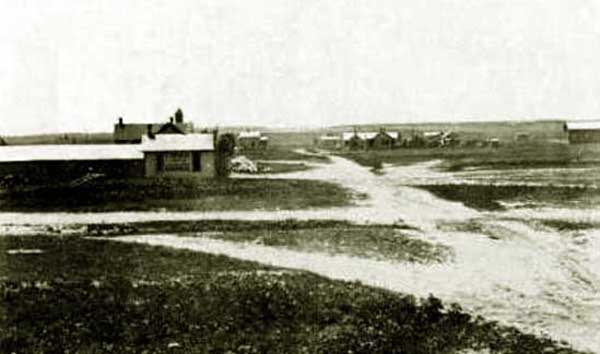
Hillsdale, Wyoming, 1901.
Hillsdale was named by Gen. G. M. Dodge after Lothrop L. Hills (1831-1867), an assistant engineer and head of
an enginering party for the Union Pacific. Hills was killed by
Indians on June 11, 1867 about six miles east of present-day Cheyenne. To protect Union Pacific crews a cavalry post
was established at Hillsdale. The names of some of the streets,
streets, Nash Ave., Coates Ave., and Markley Ave., recallduring the dry farming era when the town was at its
peak. Charles N. Coates, a railroad telegrapher, is regarded as having established the town.
He homesteaded some 300 acres and went into the
real estate business. He advertised the area as "the best dry farming land in Wyoming." Hillsdale was
promoted as the "garden spot of Wyoming." In 1916, John C. Nash, a local rancher established the Hillsdale State Bank with offices in the Cash Store..
Later the bank moved into a brick building.
Stanley K. Markley, was one of the founders of the local church and served as its pastor. Later he went into the real estate business
advertised that he sold homesteads and irrigated ranches and farms. In 1917, Markely established the town newspaper,
The Hillsdale Review
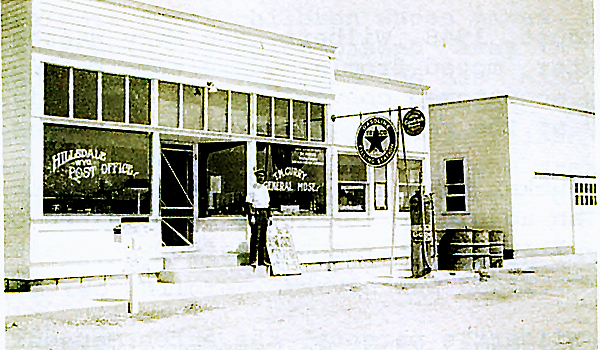
Hillsdale Post Office, 1920.
By the early 1920's storm clouds were on the horizon for the little town. A drought hit the area. In January 1921, the town was rocked by headlines in the
leading Wyoming newspapers revealing that Harry H. Nash, the twenty-one year old son of the town's banker
had been arrested in a Los Angeles pool hall for the murder in Arizona of Martin F. Schwab, a traveling typewriter and cash register salesman.
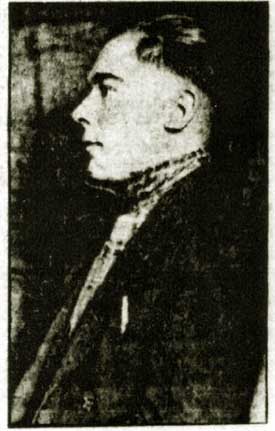 . . . . . .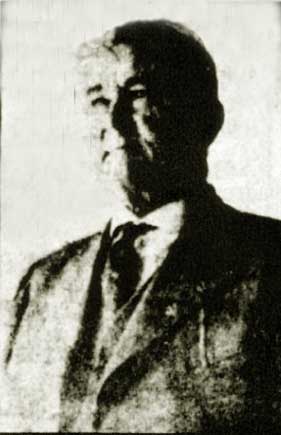
Left, Harry Nash, right, J.C. Nash
Photos from Coconino Sun, February 4, 1921
Harry Nash was a fancy and trick roping cowboy. Allegedly he had appeared in the Frontier Days celebrations but had left Wyoming
for the bright lights of Los Angeles and the movies. In April of 1920, the 50 year-old Schwab had been in Flagstaff, Arizona, and was going to proceed to
Winslow as his next call. Schwab normally wrote his wife in Utah daily. Schwab and his large 7-passenger Chandler
Automobile vanished. Mrs. Schwab wrote the sheriff in Flagstaff, but no reports of Schwab were received. That fall,
a new sheriff, Wm. Campbell, was elected. In the meantime, an elderly
hotel clerk from the Daly Hotel in Salt Lake City, B. F. Pearson, dreamed that Scwab had been murdered and that his body was
buried outside of Flagstaff. Several friends of Pearson wrote Campbell of the dream. Campbell travelled to
Salt Lake City to interview Pearson. Sheriff Campbell was convinced that Schwab had been murdered. On September24, the first break came when
two boys discovered buried in an old dry well outside of Flagstaff a typewriter and a skull. Investigation of the well also
revealed a sample case, a miniature saleman's sample cash register, a body, and documents that demonstrated that the body was that of
Schwab. Sheriff Campbell immediately suspected Harry Nash, his brother Roy Nash, and another rodeo
cowboy who had been in Flagstaff at the time of Schwab's disappearance. Harry had made some comments in
Flagstaff that he was going to buy Schwab's big Chandler. Yet, Harry appeared to be down on his luck. He had
hocked his saddle at Harper's Second-Hand Store. Harry's wife was working at the Commercial Cafe as a
waitress. Shortly after Schwab disappeared, Harry and his companions also left town to follow a wild west show. Sheriff Campbell
believed that if he could find the Chandler, it would lead back to Harry.
In October, the big break in the case came, a rodeo cowboy passing through Weiser, Idaho, had sold a large
seven-passenger Chandler. The car still had Utah license plates, but the plates had been modified to change some of the numbers. Additionally,
an effort had been made to modify the appearance of the car. Sheriff Campbell's belief proved out.
The car had been sold by Harry Nash. Upon his arrest, Nash confessed to shooting Schwab but he contended that
the 50-year old Schwab had offered him a ride to Winslow. According to Harry, on the way Schwab tried to rob him. Harry argued that
Schwab, a Mormon, appeared to be drunk. Therefore, he Nash shot Schwab in self defense. He contended that originally he intended to
turn himself in, but was afraid he wouldn't be believed. Nash therefore took the body out to an old well
he discovered and stuffed the body, sample case, and typewriter down the well, and covered the body in the well with several feet of dirt.
He used Schwab's watch to redeem his saddle. Thereafter, he followed the Rodeo circuit to Magdalena, New Mexico, up to Nebraska, to Wyoming, and
then to Idaho were he sold the car for $500.00.
Nash's father employed one of the most prominent attorneys in Los Angeles as well as Flagstaff lawyer C. B. Wilson to lead the
defense. The state traced with witnesses from all over the west Harry's movements, identification of the watch, and the car.
One of those who travelled to Flagstaff to assist in the defense as a character witness was S. K. Markley.
Even though J. C. Nash was president of the Hillsdale Bank, the cost of the trial put a strain on
his finances. According to the Coconino Sun, Sepember 16, 1921, p. 6,
the elder Nash had to borrow money from relatives and sell
a portion of his lands to pay for the defense.
The jury settled on a "compromise verdict," finding Harry guilty of second degree murder thereby saving him from the
gallows. The court denied a motion for new trial. A life sentence was declined by the court. If the court had given a life sentence,
application for parol could have been made at any time. Instead, the court sentenced
Harry to "not less that 65 years" nor more than 75 years in the state prison at Florence. Under Arizona law at the time,
application for parol could not be made before the 65 years had been served. He was initially assigned as an
assistant painter to a fellow inmate who had painted Flagstaff with bad checks. He was later assigned to the kitchen. In September 1922,
Harry attempted to escape from the prison, but was stopped by an alert guard. He was ten transferred to the "Snake Pen," i.e.
solitary confinement.
Harry's father refused to authorize an appeal. Harry's wife, who had worked as a waitress in Los Angeles, had travelled to
Flagstaff at her own expense to testify on behalf of Harry. At the emd pf the trial, according tp
the Coconino Sun, she was "stranded without even enough money to pay her board bill". Sheriff Campbell asked
J. C. Nash to pay for his daughter-in-law's fare back to Los Angeles. The elder Nash refused.
Sheriff Campbell felt that Mrs. Nash was not getting a fair deal and paid for her transportation back to Los Angeles out of his own
pocket. By his confession, Harry saved his brother Roy from also being charged with the murder.
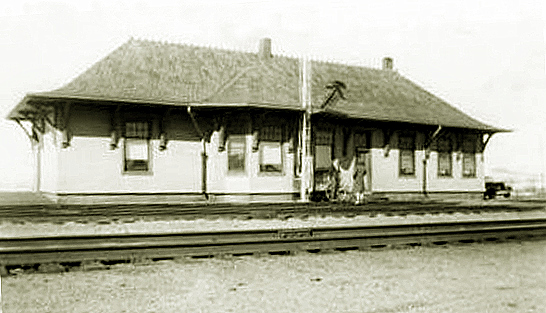
Hillsdale Depot, 1944.
In 1923, the Lincoln Highway was reconstructed and moved further to the south bypassing Hillsdale.
With the drought and the bypassing of Hillsdale, the little town faded. By 1926, the Bank was in receivership. In 1927 the Hillsdale
Review suspended publication. As of the 2000 census, the town (unincorporated) had a population of 149 and by 2010 a population of 47.
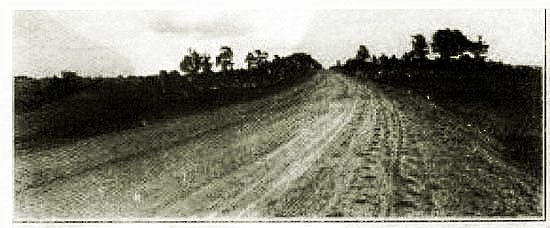
Reconstructed Lincoln Highway, east of Cheyenne, 1924.
Music this page: Weary Street Blues as recorded by Ted Daffin's Texans
Next Page, Lincoln Highway, Cheyenne to Tree-in-the-Rock.
|